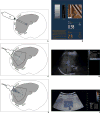Ultrasound Elastography and MR Elastography for Assessing Liver Fibrosis: Part 1, Principles and Techniques
- PMID: 25905647
- PMCID: PMC4819982
- DOI: 10.2214/AJR.15.14552
Ultrasound Elastography and MR Elastography for Assessing Liver Fibrosis: Part 1, Principles and Techniques
Abstract
Objective: The purpose of this article is to provide an overview of ultrasound and MR elastography, including a glossary of relevant terminology, a classification of elastography techniques, and a discussion of their respective strengths and limitations.
Conclusion: Elastography is an emerging technique for the noninvasive assessment of mechanical tissue properties. These techniques report metrics related to tissue stiffness, such as shear-wave speed, magnitude of the complex shear modulus, and the Young modulus.
Keywords: MR elastography (MRE); MRI; elasticity; elastography; liver fibrosis; shear stiffness; shear wave; ultrasound; viscoelasticity; viscosity.
Figures






References
-
- Sarvazyan AP, Rudenko OV, Swanson SD, Fowlkes JB, Emelianov SY. Shear wave elasticity imaging: a new ultrasonic technology of medical diagnostics. Ultrasound Med Biol. 1998;24:1419–1435. - PubMed
-
- Sandrin L, Fourquet B, Hasquenoph JM, et al. Transient elastography: a new noninvasive method for assessment of hepatic fibrosis. Ultrasound Med Biol. 2003;29:1705–1713. - PubMed
-
- Nightingale K, McAleavey S, Trahey G. Shear-wave generation using acoustic radiation force: in vivo and ex vivo results. Ultrasound Med Biol. 2003;29:1715–1723. - PubMed
-
- Muthupillai R, Lomas DJ, Rossman PJ, Greenleaf JF, Manduca A, Ehman RL. Magnetic resonance elastography by direct visualization of propagating acoustic strain waves. Science. 1995;269:1854–1857. - PubMed
Publication types
MeSH terms
Grants and funding
LinkOut - more resources
Full Text Sources
Medical

